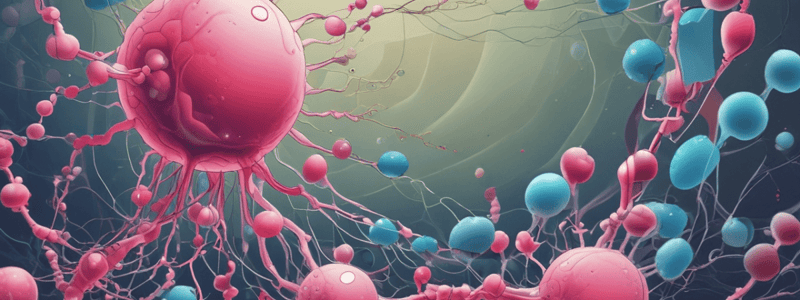Podcast
Questions and Answers
What is the primary function of surfactant in the lungs?
What is the primary function of surfactant in the lungs?
- To decrease surface tension between water and air (correct)
- To produce mucus in the airways
- To increase surface tension between water and air
- To regulate oxygen levels in the blood
What is the chemical composition of sphingomyelin?
What is the chemical composition of sphingomyelin?
- Glycerol, phosphoric acid, and fatty acid
- Glycerol, fatty acid, and choline
- Sphingosine, phosphoric acid, choline, and fatty acid (correct)
- Fatty acid, sphingosine, and galactose
What is the primary component of ceramide?
What is the primary component of ceramide?
- Glycerol and phosphoric acid
- Sphingosine and fatty acid (correct)
- Fatty acid and choline
- Sphingosine and glycerol
Where are cerebrosides primarily found in the body?
Where are cerebrosides primarily found in the body?
What is the common component of all glycolipids and sphingomyelin?
What is the common component of all glycolipids and sphingomyelin?
What is the likely outcome for premature infants lacking sufficient surfactant?
What is the likely outcome for premature infants lacking sufficient surfactant?
What is the definition of complex lipids?
What is the definition of complex lipids?
What are phospholipids composed of?
What are phospholipids composed of?
How are phospholipids classified?
How are phospholipids classified?
What type of phospholipid has glycerol as the alcohol?
What type of phospholipid has glycerol as the alcohol?
What is the most abundant phospholipid in membranes?
What is the most abundant phospholipid in membranes?
What is the property of phospholipids that allows them to form bimolecular layers?
What is the property of phospholipids that allows them to form bimolecular layers?
What is the orientation of the polar group in a phospholipid bimolecular layer?
What is the orientation of the polar group in a phospholipid bimolecular layer?
What is the function of phosphatidylcholine (lecithin) in the body?
What is the function of phosphatidylcholine (lecithin) in the body?
Flashcards are hidden until you start studying
Study Notes
Complex Lipids
- Compound lipids are esters of fatty acids containing groups in addition to an alcohol and one or more fatty acids.
- Phospholipids are a type of compound lipid that contains an alcohol, fatty acid, phosphoric acid, and a nitrogenous base (choline, serine, inositol) or other alcoholic group.
Phospholipids
- Phospholipids are classified into two types based on the type of alcohol present:
- Glycerophospholipids: contain glycerol as the alcohol
- Sphingophospholipids: contain sphingosine as the alcohol
Glycerophospholipids
- Examples include:
- Phosphatidyl choline (lecithin)
- Phosphatidyl ethanolamine (cephalin)
- Phosphatidyl serine
- Phosphatidyl inositol
- Cardiolipins
- Plasmalogens
Phosphatidyl Choline (Lecithin)
- The most abundant phospholipid in membranes
- Represents a large proportion of body store of choline
- Acts as an active agent "Surfactant" that lowers surface tension
- Contains alcohol, fatty acid, phosphoric acid, and choline
- Major surfactant produced by certain cells within the lung, preventing alveoli from collapse by decreasing surface tension between water and air
Sphingomyelin
- A sphingophospholipid that does not contain glycerol but an unsaturated amino alcohol, sphingosine
- Contains a molecule of choline, phosphoric acid, and a fatty acid
- Makes up a large part of the myelin sheath found in nerves
Ceramide
- Composed of sphingosine and a fatty acid joined by an amide bond
- Common to all glycolipids and sphingomyelin
Glycolipids
- Lipids containing a fatty acid, sphingosine, and carbohydrate
- Examples include:
- Cerebrosides: contain a molecule of fatty acid, an amino alcohol sphingosine, and a sugar (usually galactose)
- Found in the white matter of the brain and myelin sheath of nerves
Studying That Suits You
Use AI to generate personalized quizzes and flashcards to suit your learning preferences.




